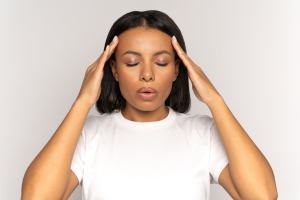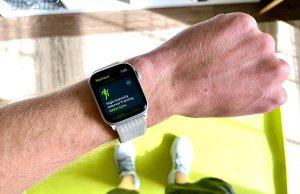Anxiety can take your emotions from stable to elevated and nearly out of control very quickly. This can mean anything from feeling disproportionate worry to having panic attacks. That’s why it’s important to have solid coping and grounding techniques to help yourself either avoid these situations or bring your emotions back down if they get ramped up or feel uncontrollable.
The “333 rule” is a grounding technique that brings focus to an individual’s immediate surroundings to take attention away from their spiraling emotions.

What Is the 333 Rule?
The 333 rule is a grounding technique that redirects attention from intense and uncomfortable anxiety symptoms (like worry, unwanted thoughts, or even panic) to the present by shifting focus to three bodily senses: sight, hearing and touch/movement.
Using the 333 rule, you intentionally take in information about your environment using your senses: In practice, it looks something like this:
- What are 3 things you can see? Look for the specific qualities of your surroundings, such as colors, shapes, or other remarkable characteristics. Try looking for things you haven’t noticed before, such as different shades of blue or patterns.
- What are 3 things you can hear? Listen for specific sounds happening around you. Isolating sounds you normally tune out, like a fan running or traffic noise, can enhance the experience.
- What are 3 things you can touch or move? Exploring the qualities (weight, texture, etc.) of tangible objects near you is a great way to feel grounded. Analyze them—how would you describe them? What is the sensation of touching them like?
Does the 333 Rule Help With Anxiety?
Many people find the 333 rule to be helpful with anxiety. The 333 rule combines the benefits of a grounding technique with a memorable title, making it easier to remember and reach for, even in a panicked or overwhelmed state.
One way of thinking about anxiety is that it’s like your body’s emotional alarm system. It lets you know when there is danger, so when it is going off and causing distress, it may require relief to turn the alarm off.
The 333 rule is an easy method to remember to help reduce the uncomfortable symptoms associated with anxiety. It creates space between you and whatever is triggering the worrisome thoughts by shifting focus to your physical environment as received through the senses.
It’s also helpful to use measured breathing alongside any grounding technique. You can use your breath to anchor yourself by steadying your breath to a slow, rhythmic pace as opposed to forcing breaths “in and out.” This technique can also help alleviate anxiety.
Why Does the 333 Rule for Anxiety Work?
Grounding techniques such as the 333 rule are helpful for anxiety because they help us stay in the present moment by engaging with the details of our environment and using our brains in a different way. It gives our brain a break by taking us out of our head and giving our body time to come down from where it was working itself up to.
When to Use the 333 Rule for Anxiety
To know when to use the 333 rule for anxiety, it’s helpful to first identify anxiety symptoms. Symptoms for anxiety might include restlessness, feeling tired, struggling to focus, sweating or trembling, increased heart rate, a sense of impending danger, headaches, and stomachaches. If you experience some of these anxiety symptoms, it is a good time to employ the 333 rule for anxiety. Using this grounding technique can help alleviate some of the symptoms.
What Is the 54321 Technique?
The 54321 technique is another grounding technique similar to the 333 rule. It also helps redirect attention to the present and draw it away from unpleasant anxiety symptoms by engaging all the senses. With the 54321 technique, you engage all five senses.
- What are 5 things you can see? Challenge yourself to go beyond the obvious.
- What are 4 things you can touch? How would you describe it?
- What are 3 things you can hear? Practice hearing without judging, simply observe.
- What are 2 things you can smell? Is there a feeling associated with that scent?
- What is 1 thing you can taste? What are tastes that might be lingering on your tongue?
Much like the 333 rule, the 54321 technique’s purpose is to pull you away from uncomfortable or overwhelming feelings so that you can focus on the present, mitigating them before they become too much.
What Immediately Helps Anxiety?
Because anxiety is a reaction to danger, the best way to diffuse it is to figure out what your mind thinks is the source of the danger.
There are a few ways to proceed from there, depending on the issue. Sometimes, anxiety disorders cause someone to react intensely to something that is not dangerous or life-threatening. Other times, anxiety can make normal problems and issues feel insurmountable.
Common strategies for relieving anxiety include:
- Challenging thinking errors. If your response is disproportionate to a situation (i.e. anxious response to a non-threatening situation) it may help to challenge your thoughts. The thoughts we have racing through our minds aren’t always facts, and it’s good to make a point to distinguish the two (thoughts and facts) when you feel anxious. What feels like fact could be a case of jumping to conclusions or trying to read the minds of others. Consider instead taking a perspective of positivity and seeing if your position or thoughts change.
- Apply problem-solving skills. This approach encompasses many strategies, including coping skills (journaling, listening to music), relaxation skills (deep breathing, grounding), and enlisting support (talking to someone). Each of these can be helpful in different situations where your anxiety is making it hard to assess problems and come up with solutions.
What Are 5 Coping Skills for Anxiety?
People use a variety of coping skills to reduce their anxiety and quiet their minds. Some of the most common coping strategies are:
- Relaxation techniques such as grounding techniques, mindfulness, meditation, deep breathing, or progressive muscle relaxation.
- Express yourself, whether that be through journaling, talking to someone, having a laugh, crying, or through creative expression like art.
- Shift your perspective by trying to develop another skill or by finding ways to put your attention elsewhere.
- Physical activity such as taking a walk, lifting manageable weights, or dancing.
- Participate in a hobby. What are things you enjoy or used to enjoy doing?
You can use any combination of skills to help with your anxiety—whatever feels most natural and most effective will likely be the best option for you. A good way to find out what works best would be to discuss techniques with a mental health professional. They can give you expert suggestions and help you assess what options are most healthy for you.
How to Stop Anxious Thoughts
Using the 333 rule is a great grounding technique to move through anxiety as it is happening. But there are many things you can do to stop anxious thoughts from arising in the first place. Here are three tips to help you stop anxious thoughts.
- Redirect unhelpful thoughts. Anxiety can often cause your mind to catastrophize or underestimate your ability to handle what’s on your plate. If you lean into these thoughts, you can start to believe them as true instead of seeing them as thoughts rather than facts. Try thinking through your past accomplishments or implementing some problem-solving strategies to help yourself work through what you’re facing and believe in yourself more.
- Develop healthier self-care routines. Things like a lack of sleep, poor eating habits, and inactivity can worsen anxiety. Even though it might feel difficult to change your routine, try adjusting one thing at a time, like taking a walk or going to sleep 30 minutes early. Even small changes can make a difference in the intensity of your symptoms.
- Work on creating healthier coping techniques. When you haven’t been taught to manage your anxiety symptoms in a sustainable way, you can develop unhealthy coping techniques on your own to help. This might look like oversleeping or catastrophizing, or more serious like undereating or substance abuse. Each of these can feel like they help your symptoms in the short term but will eventually worsen them in the long run. It’s important to work to implement healthy coping techniques whenever you can so that your anxiety symptoms are managed in a way that works in the long term.
The Bottom Line
The 333 rule is a great tool to have up your sleeve if you start noticing signs of anxiety. In addition to using the 333 rule, consider talking to a mental health professional who can help you sort through unhealthy coping techniques and provide support as you work to improve your anxiety symptoms. A therapist can also help you figure out the causes of your anxiety.













